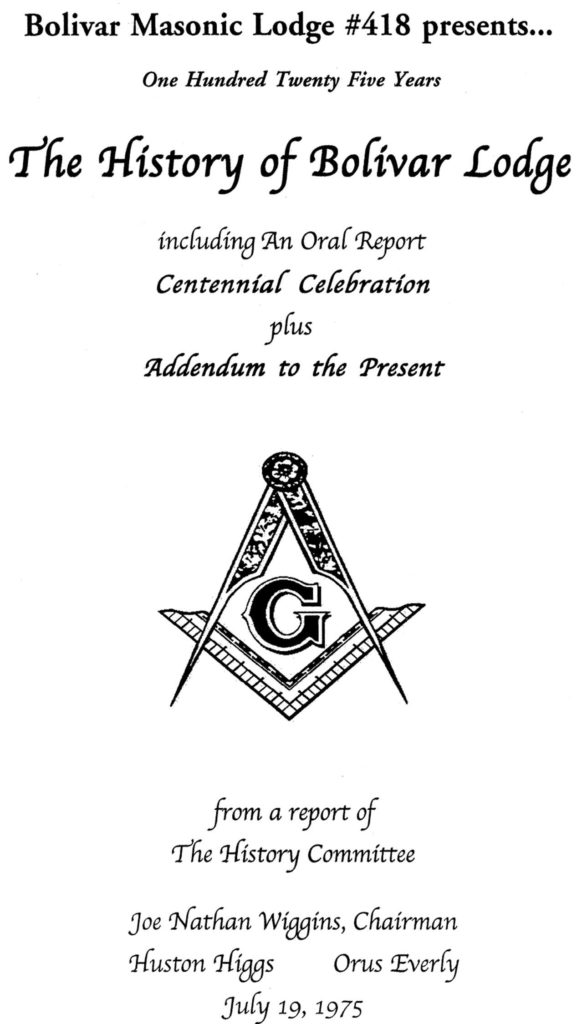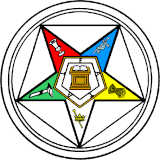Our History
Helping Others Is A Calling
- Bolivar Masonic Lodge #418 Presents. . .
- Centennial Report
- How The Town of Bolivar Received Its Name
- The History of Bolivar Texas
- Bolivar Lodge #418 is Chartered
- New Location of Bolivar Lodge
- Drawn To A Close
- Addendum to the Present

The History of Bolivar Lodge #418, A.F. & A.M.
A Centennial Report
July 19, 1975
The Centennial Year means something special for the members of Bolivar Lodge #418, A.F. & A.M., Sanger, Texas, since it marks the 100th year of this lodge in the State of Texas.
When the Masons of Sanger noted the unusual milestone, they appointed a committee to prepare the history of the Lodge. This committee consisted of Joe Nathan Wiggins, Huston Higgs, and Orus Everly. The Chairman of the committee, Joe Nathan Wiggins, immediately went to the records and spent hours at his task of gleaning and condensing the most important facts of this long period of time. He found the records full and comprehensive and written in the longhand penmanship of a past generation. The penmanship was excellent and unique, and would be of interest to every person.
Sanger dates to 1887, when the Santa Fe railroad brought the town into being. The history of Bolivar Lodge goes back, however, to the town of Bolivar located four miles west of Sanger. The first records of Bolivar Lodge date back 109 years ago, when Okalla Lodge U.D. was granted dispensation on July 12, 1866. This was nine (9) years prior to the charter eventually granted what is now Bolivar Lodge #418. With the idea of “first things first,” the chairman wrote to the Grand Lodge of Texas for facts concerning Okalla Lodge as well as Bolivar Lodge #418.
The following is a quote received from the information furnished by the Grand Lodge of Texas: “Okalla is a frontier lodge with difficulties….but with true and trusty craftsmanship continuing under dispensation.”
Minutes of Okalla Lodge U.D. indicate they were granted dispensation July 12, 1866, by Right Worshipful Grand Master Douglas to open and hold a lodge in the vicinity of Bolivar, Denton County.
Information of Proceedings from the Grand Lodge of Texas,1869: “Okalla Lodge, U.D., holds meetings at Post Oak Church, Denton County Texas. This lodge is on the extreme frontier in a section of the country infested by savage Indians. They have been trying to work for three years, the dispensation having been granted by Right Worshipful Past Grand Master Douglas in 1866. The lodge has had much intermittent success as is shown by the reports before us, therefore, we feel compelled to recommend that the dispensation be discontinued. Fraternally submitted, Committee on work.”
Okalla Lodge minutes referring to above:
“Whereas this is the last meeting of this lodge prior to the next meeting of the Grand Lodge, and it being necessary that we return our dispensation, be it resolved that we advise that the Indians are again making inroads into our vicinity and are disturbing the peace of our citizens, and be it further resolved, therefore, that we at the present time ask of the Grand Lodge a continuation of our dispensation for another year.”
Signed, A.J. Nance, Secretary
(Note: Many communications to the Grand Lodge, and minutes of the lodge were signed by A.J. Nance, a moving force in the lodge. Nance was a charter member of Okalla Lodge. He was also a charter member and officer of the Bolivar Lodge and again of the Sanger location. He was beyond a doubt the man who gave the most to masonry for the longest period of time.)
How The Town of Bolivar Received Its Name
It was Dr. Hiram Daily who laid off the town of Bolivar into town lots early in the 1850’s. He was not only the town’s doctor but preacher as well. He also had a store that dispensed all kinds of goods as well as drugs. The circuit rider, Rev. William H. Allen, tells of holding services in the home of Dr. Daily in the days when Rev. Allen was serving a parish “200 miles South of the Red River”.
When Dr. Dally laid off the town, he called it New Prospect. It was called this until one Ben Brown came out from Tennessee, and decided the new town should be called Bolivar. This was the name of the town in Tennessee which Ben Brown came from. (It was named after a man by the name of Bolivar). The controversy was submitted to the people when they voted on secession in1861 and Bolivar was the name chosen. This was no discredit to the doctor and preacher, he just didn’t pass out beer with a promise to vote as the Brown constituents did. Dr. Daily, with his pioneer spirit, went on to other less settled frontiers about 1870.
The History of Bolivar Texas
One hundred years ago, Bolivar was the axis for the trails and roads of North Texas. It was the center of the corridor to the Red River, west of the cross timbers, and by now, a little west of the Indian-raided western counties.
It was rapidly being settled by those who took up land (presumably from the government, and cattle was the chief industry). The people of this area, along with “true and stalwart” Masons as the Grand Lodge described them, once again wanted to try to establish a Masonic Lodge. Many were members of the Okalla Lodge, others from lodges previous to that date, but all were interested in forming a new lodge.
The future Bolivar Lodge #418 A.F. & A.M. met in the lodge room at Bolivar, Texas, for the purpose of organizing a lodge, when authority was granted by the Grand Lodge of Texas in 1874. The lodge opened in the “Masters” degree with Bro. J. M. Blount, of Stanfield Lodge #217, Denton, Texas, presiding. Bro. Blount was legally authorized by D. J. Eddleman to organize the lodge and he proceeded to carry out this official duty.
Officers Present:
- Bro. G. A. Grissom, W.M.
- W.K. Logan, Sec.
- E. Howard, S.W.
- W.F. Whltehead, S.D.
- J.R. Fuller, J.W.
- John Garrison, J.D.
- W.A. Garrison, Treas.
- H. Hardiste, Tyler
On agreement of motion, the lodge decided to hold stated meetings on the first Saturday after each full moon at the hour of 6:00 p.m. By-laws were adopted as laid down in Taylor’s Monitor for the government of the Lodge. The lodge voted to set dues at $2.00 each per annum. Lodge was duly closed, “peace and harmony” prevailing. (W.H. Logan, Sec. pro tem)
Bolivar Lodge #418 is Chartered
After the legally authorized Bolivar Masonic Lodge #418 A.F. & A.M. was chartered on June 4, 1875, a meeting was held in the lodge hall on June 19, 1875. History reveals that at this meeting a letter was composed and sent to the honorable Joseph U. Sayers on his 84th birthday by J.S.J. Gober, Secretary, to congratulate him on his birthday and again thank him for signing the charter of Bolivar Lodge. lt is interesting to note that Sayers was later Governor of Texas. At this same meeting, officers were elected for the ensuing year and installed by Bro. D.R. Grafton, District Deputy Grand Master. They were:
- G.A. Grissom, W.M.
- W.F. Whitehead, S.D.
- E. Howard, S.W.
- James F. Knox, Sec.
- J.R. Fuller, J.W.
- A.M. Russell, J.D.
- J.F. Jones, Treas.
- M. Smith, Tyler
Members Present: C. Allingham, J.D. Pollard, I. Griffith, L.A. Holland, and H. Burgh. Visitors Present: D.L. Grafton, District Deputy Grand Master, Stanfield Lodge #217, Denton; L.L. Stowe and James Young, Travis Lodge #117.
The year 1875 was a busy one with committees appointed and work done by all with great willingness. The Finance Committee was one of the first to organize and function. In September, 1875, the matter of a lodge building was introduced. It was customary at that time in Texas for Masonic Lodges to build a lodge hall with rooms for a school and church. A committee was appointed to meet with the trustees of Bolivar School to obtain a title deed for the building. In December, this committee reported favorably and a deed was secured. (An interview with the historical committee tells that E.W. Bentley built the first lodge house in Bolivar in 1875 and this building was also used for school and church by all denominations. A picture of this first building was published in the Sanger Courier during the 100th Anniversary week of July 19, 1975).
D. Carter, former editor of Texas Grand Lodge Magazine says, “Free Masonry is one of the most potent forces that shaped the development of the educational system of Texas.” He goes on to say, “The more liberal atmosphere of America was created principally by Masons.”
The first year of Bolivar Lodge, #418, closed with a great deal of satisfaction among the members for things accomplished. With Okalla behind, a charter from the Grand Lodge, a building of their own with deed to the land, bills for furnishings paid including “one dozen chairs, two dozen spittoons, and candles”, and committees functioning well, they did indeed have a great deal in which to find satisfaction.
Early in 1876, Bolivar Lodge voted to join the IOOF Lodge in buying a tract of land for a cemetery at Bolivar. This land, consisting of 11 1/2 acres was located east of Bolivar, and was purchased from Mr. William Chadwell at a cost of $112.50. A division was made of the land and a fence built at a cost of $129.36. The committee consisted of A.J. Nance, J.W. Gober, W.A. Garrison, and D.D. Clampitt. Members provided lumber and carpenter work on coffins, provided burial clothes for members, kept the cemetery in good condition, and provided ornamental appointments and landscaping. Bro. G.A. Grissom died in February, 1876. He was likely the first Mason to be buried in the Bolivar Cemetery. Grissom was Worshipful Master for Okalla and also Bolivar Lodge #418.
The first community celebration was perhaps ln June, 1855, 10 years after receiving a charter. The lodge celebrated ten years of active lodge activities during a period when many new members joined. This community celebration included a picnic, and the public installation of officers.
These ten years marked the height of Bolivar’s history as a pioneer fort and town. The Texas-Kansas Eastern Cattle Trail, and other trails, of which the Butterfield was perhaps the best known, were joined by the John Chisum Trail. The Chisum Trail went east and west from his land located northwest of Bolivar, and extended all the way to Shreveport, La. All along these trails, telegraph lines were established and stage coaches traveled with the coaches often staying in Bolivar for the night at one of its three hotels. Overland transportation was the great issue in pioneer times and it made Bolivar a growing town but also caused it to lose its prominence when the railroads took over and the overland trails were no longer needed.
The New Location of Bolivar Lodge
In 1887, the Gulf, Colorado and Santa Fe Railroad was extending its lines in South and East Texas to join national lines to Chicago, Illinois. The route selected was the open corridor from Fort Worth, Texas to Ardmore, Oklahoma. As the railroad was finished, the town of Sanger, along with other towns, were located and established along the railroad route. It was inevitable that this new railroad would move the area of action from Bolivar to the new town of Sanger. The long trail drives were no longer necessary as the cattle from the ranches were driven to the railhead at Sanger and then shipped by rail to their destination. Transportation and supplies were now available as never before and the area continued to grow. Many of the men who helped to build Bolivar were now helping to build Sanger.
Reading of the minutes revealed to the researchers that early in 1894, Bolivar Lodge issued an important call to all brethren to meet in February to vote on the matter of moving the lodge to Sanger.
This meeting is recorded and shows that by unanimous vote it was ordered that Bolivar Lodge #418, A.F. & A.M. be moved to the town of Sanger. Bolivar Lodge remained the same except for meeting in a new location. The meeting in February, 1894, was the last to be at Bolivar. (A.J. Nance was W.M. and W.J. Nance, Sec.)
The first meeting of Bolivar Lodge in Sanger was held in the F.M. Ready Building and the rent was $8.00 per month. Officers of the lodge remained the same, several of whom now lived in Sanger. Among these were A.J. Nance, J.D. Bourn and his brother, A.M. Bourn, Eugene Howard, Dr. Ewing Howard, and several others. Visitors to the first meeting in Sanger were E.L. Long, Morristown, Tenn., R.A. Greene, Sneedville, Tenn., Andy M. Wilson, Pilot Point, J.R. Sullivan, Pilot Point, B.F. Gafford, Forestburg, A.H. Goff, Santa Fe Agent from Cleburne, Texas, and others. Rent was paid to Dr. A. A. Abney, son-in-law of Mrs. Hulling the original owner of the Sanger location and was likely the Ready Building.
In April 1898, J.L. Burt, general store owner in Sanger, built a two story building on Bolivar Street in Sanger. Mr. Burt leased the upper floor to Bolivar lodge. In October, 1900, Bolivar Lodge #418 moved once again. After a storm, which severely damaged a building used for school, the lodge gave assistance to the Sanger School Board of Trustees in obtaining a loan to provide a school building. Once again, as was the tradition of Masons, the community was assisted in constructing a school building. The building was also used as the meeting place of the Lodge.
This was not a permanent home for the Lodge and the following year a committee of Bros. Nance, Gober and Seal took steps for a permanent lodge home. J.W. Millligan, a devoted Mason, had a one story brick building. He offered the upper part of his building for the Masons, to be constructed and owned by them. The committee in charge of this move and acceptance of Milligan’s offer was composed of T.A. Gentle, H.V. Duncan, J.W. Milligan, and B.G. Vaughn. This committee was assisted by the Finance Committee which was made up of A.J. Nance, A.F. Warren, and J.R. Sullivan. Bro. Milligan’s offer was for the Masons to add a second story to his building to be used and owned by them.
May 13 1905, dates the accomplishment of a permanent home for Bolivar Lodge. On a motion by H.E. Hicks and seconded by J.H. Sullivan, action was taken to complete the upper story of the building which became the permanent home of the lodge.
The first meeting to be held in the new lodge facility was June 10, 1905. One of the first actions taken by the lodge was to grant the Eastern Star permission to use the Lodge Hall. This organization was especially active in the 20’s and 30’s. Mrs. Lula LeFan from the Grand Lodge Eastern Star, held regular instruction periods and many of the women became proficient in the work. Several received state recognition at the annual meeting in Galveston in the late 30’s. Minutes of the years following the move into the new home, indicate the lodge was extremely active with all bills paid and finances carefully checked. The characteristic activities of the lodge were carefully itemized, such as help to members in Slidell after a storm had done considerable damage.
The lodge grew rapidly and a letter from the lodge to the Honorable Joseph D. Sayers, P.G.M., and governor of Texas indicates that on September 22, 1925, the lodge had almost 100 members. This indicates the success of the lodge even during difficult times. The period from the time of receiving the charter until the time of the letter mentioned was a period of ups and downs. About the time of World War I, Bolivar Lodge had varying successes and failures. Realizing steps must be taken to increase interest and attendance, a contest was planned. W.F. Burroughs was made captain of the Senior team and H.P. Melton was captain of the Junior team. Both teams were to learn more about lodge work and this move brought success.
There was a need to eliminate friction within. In 1917, when the attendance dropped to a new low, a call to all the brethren was made. As always, the members responded with thirty one present. Inspiring talks were made by J.T. Chambers, H.D. Greene, J.H. Barnes, Rev. Dodson, Dr. G.D. Lain, J.W. Milligan, H.P. Melton, and J.H. Hughes. These talks resulted in the restoration of peace and harmony. Bro. Pender, a devout and trusted Mason, led in prayer as members joined hands around the altar. It was an old-fashioned hand shaking meeting, so the record shows.
A special meeting is noted in the records of 1917. A called meeting was held for the purpose of laying the cornerstone of the new Sanger High School Building. Following the traditional interest of Masons in schools, the cornerstone was laid according to the most ancient custom and usage of the order. Twenty one members and visitors were present and Bro. J.W. Pender of Denton gave the address.
In 1917, Bro. A. J. Nance died. He is referred to more often in this history than any other Mason. He was a charter member of both Okalla Lodge and Bolivar Lodge, serving the Lodge at both of its locations (Bolivar and Sanger). It is believed he was a devoted Mason longer than anyone in the history of this lodge.
The 1920’s began with a memorial to service men who had served during World War I. Also, the Masonic Home and School was inaugurated in the 1920’s. Grand Master Mike Thomas visited the lodge on behalf of this state-wide undertaking. The goal was to raise $1,000,000, a considerable sum for this period of time in history. The 65 members present all made pledges to help raise the needed funds. The lodge divided into groups to help raise money and pledges for this worthy project. J.S.J. Gober, B.G. Vaughn, A.L. Gentle, and Rev. C.N. Smith were team captains in charge of pledges. They all did a marvelous job and Bolivar Lodge #418 contributed generously to this project of providing a Masonic Home and School. The lodge continued in the years to follow, to give great support to the schools and hospitals which increased in number and size each year. Children were sent to each of these institutions, especially the crippled children’s Hospital.
The lodge was always willing to respond to the needs of people in the local area as well as in other places. Relief to those who suffered from floods was common, and floods were common in those days. Wherever a need arose, the lodge was always willing to do what it could. In the early 1900’s, a portrait of George Washington, who was a Mason, was hung in the Lodge Hall. This created a great deal of excitement and enthusiasm among the members.
It would take many more pages, and considerably more time, to tell of all that happened during the 100 years of activities of Bolivar Lodge. Individual members and their contributions would fill pages. It should be emphasized that the ones who are named in this brief history were conspicuous in their contributions, but they are named with no discrimination for the many others who may not have made the headlines, but were loyal and devoted masons. The Grand Lodge termed all of them, “true and stalwart men.”
******************************************
As this historical resume is drawn to a close, let me invite you to read and examine the many historical documents and records which the chairman of this committee, Joe Wiggins, has compiled and edited for presentation. I believe it would be appropriate at this time to express our deepest gratitude to Mr. Joe Wiggins and his committee for a job well done. This committee, consisting of Joe Wiggins, Huston Higgs, and Orus Everly, has done a magnificent work in researching the history of Bolivar Lodge and making it available to the general public. At the same time, we want to express our deepest gratitude to Mrs. Alma Chambers who spent many hours working on the historical data and did a great deal of typing and other work. Mrs. Chambers was well qualified to do this important work since she has been associated closely with the history of Sanger and surrounding area, and especially with Masonic work…..her husband, father, and grandfather all having been masons.
******************************************
Editor’s note: This report was given during the Centennial Celebration of Bolivar Lodge on July 19, 1975 by lodge chaplain the Rev. George Clerihew. The ceremonies were held at the Sanger Elementary School cafeteria with the welcome given by the then current Worshipful Master Charles W. (Bill) Kesseler. Visitors and past masters were recognized by Ken Hoops, Junior Warden, and the guest speaker, Past Grand Master Bill Proctor, was introduced by George A. Wood, D D.G.M. of the 84th District of the Grand Lodge of Texas.
Portions of this oral report have been edited and clarified by me to fit into this pamphlet. Original text was preserved as much as was possible. It is my belief that nothing has been omitted or deleted that would change the essence of this writing.
Addendum to the Present
Throughout the middle to latter part of the 20th century Bolivar lodge continued to be very active within the communities of both Bolivar and Sanger. As Sanger continued to grow, the main focus of activities remained within this community.
The old lodge building has been occupied since the top floor was constructed by the lodge for $2690 in 1905. In March 1965, the bottom floor was purchased. The 1970’s began with the lodge replacing the old flooring of the bottom floor with concrete and later the installation of a suspended ceiling in both the upper lodge room and the downstairs meeting hall. Orus Everly, lodge member and electrician, installed 220 volt outlets to the upper floor in 1975 and window air conditioning units were installed and the lodge hall had its first taste of true comfort. The interior of the lodge was repainted in anticipation of the Centennial celebration. The Centennial Celebration was an overwhelming success. The Sanger Courier printed a full four page section on the history of the lodge as well as front page stories. Worshipful Master Bill Kesseler introduced Past Grand Master Bill Proctor who was the featured speaker for the occasion.
With the installation of new drop ceilings, central air conditioning was soon installed. New cabinets and paneling in the bottom banquet hall soon rounded out the renovations. The meeting room saw new carpet and a new $7000 roof in the late 1990’s and also repairs to windows and trim.
The 1980’s began quietly for Bolivar Lodge as Masonic attendance and membership statewide began to dwindle. Bolivar lodge was not representative of this trend as its membership increased from 78 in 1975 to about 95 members presently.
In the middle 1980’s, many members from the Krum area joined the lodge and became active. Several rose to the Master’s chair. With this change in the makeup of the lodge, the lodge began to divide its focus and energy between the two communities of Sanger and Krum. In the late 1980’s, friction between lodge members of the two communities began to develop as funds and activities were directed toward Krum.
With no lodge of their own and all three chairs now filled with Sanger brethren, members of the Krum community decided to form their own lodge in 1989. A vote was taken on a jurisdictional request to allow the formation of Krum Lodge and to use Bolivar Lodge as a backup meeting place. The motion was passed on September 10, 1990.
Applications for Certificates of Good Standing were sought by 17 Krum members at the June 11, 1990, stated meeting and officer elections. One would have thought this would have severely crippled Bolivar Lodge. This was not the case. With the “Sanger locals” back in control, new members from the Sanger area began to join and again Bolivar Lodge was back on track as membership grew to near 95 today.
Competition for free time and the need for both spouses to work outside the home has been a burden for membership and attendance of Masonic Lodges in the 1990’s. Bolivar lodge has fared much better than many other lodges throughout the state. With a commitment to the principles of freemasonry and the idea that “I Am My Brother’s Keeper,” our lodge is well positioned to enter the 21st century healthy and well prepared. We strive to maintain that frontier spirit and determination of our founding Fathers of Okalla and Bolivar lodge who blazed the trails before us.
Fraternally submitted as editor, Charles F. Kesseler, Treasurer & PM A.D. 2000 Bolivar Lodge #418 June 2000










